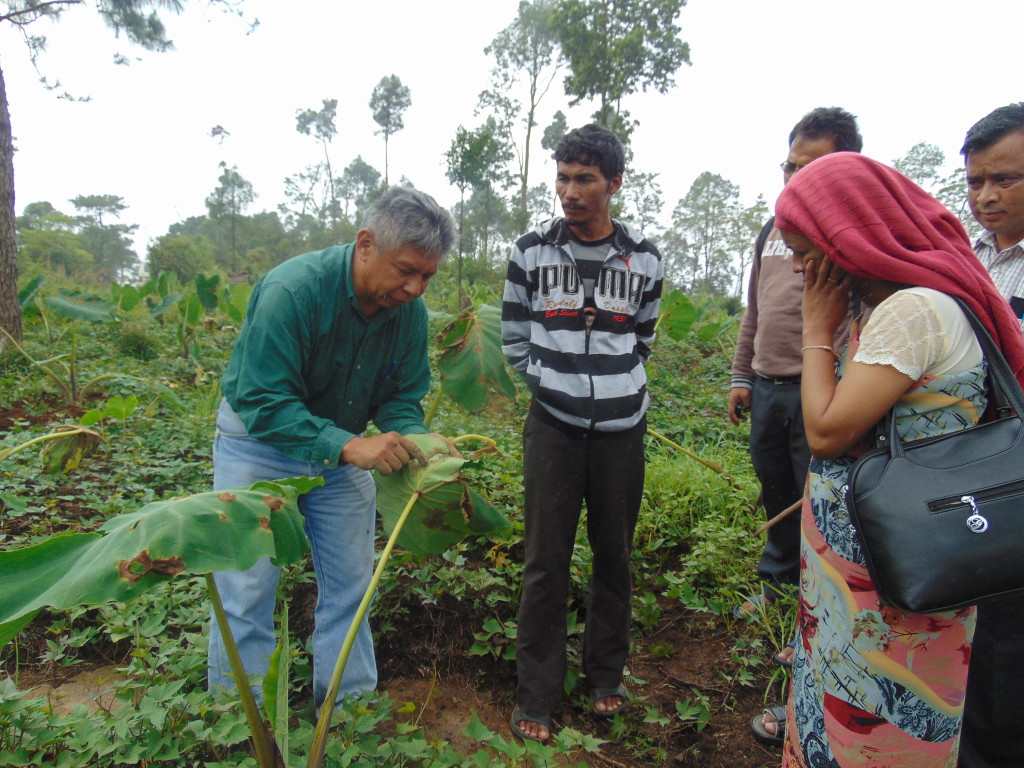 In the last leg of his tour of villages in Meghalaya Dr Francisco visited Moosakhia, Jaintia Hills on the 25th of August 2015; he visited Porkasi and Pyndengmawlieh in West Khasi Hills District on the 20th and 2st August and Khweng, Ri-bhoi District on 24th August.
In the last leg of his tour of villages in Meghalaya Dr Francisco visited Moosakhia, Jaintia Hills on the 25th of August 2015; he visited Porkasi and Pyndengmawlieh in West Khasi Hills District on the 20th and 2st August and Khweng, Ri-bhoi District on 24th August.
Accompanied by the NESFAS team, Dr Francisco met Custodian Farmers Realsing Muksor, Petrus Suting and Loren Pakheng among others who took him to see their various fields.Dr Francisco as seen in his other visits immediately got down to work understanding the farming systems of the people there and in the process identifying trouble spots and offering solutions.
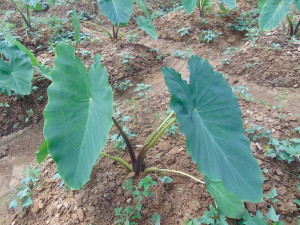 The first stop was at Realsing’s field where he grew yam. Just by looking at the leaves, Dr Francisco was able to tell that the crops were in trouble. Realsing pointed out how the leaves were attracting a particular kind of fungus that was causing the leaves to rot. According to Dr Francisco the disease was being caused by a fungus that is transmitted through airborne spores. The solution – planting natural fencing barriers like corn that could shield the yams. As if to prove Dr Francisco’s point, when they visited another patch where yam grew, they saw that the crops were healthy and the leaves were beautiful and that the plants were surrounded by a natural barrier of corn plants.
The first stop was at Realsing’s field where he grew yam. Just by looking at the leaves, Dr Francisco was able to tell that the crops were in trouble. Realsing pointed out how the leaves were attracting a particular kind of fungus that was causing the leaves to rot. According to Dr Francisco the disease was being caused by a fungus that is transmitted through airborne spores. The solution – planting natural fencing barriers like corn that could shield the yams. As if to prove Dr Francisco’s point, when they visited another patch where yam grew, they saw that the crops were healthy and the leaves were beautiful and that the plants were surrounded by a natural barrier of corn plants.
Realsing’s excitement was obvious and he did not stop himself from hugging Dr Francisco and thanking him. Dr Francisco too voiced out how he was glad to be of help and to having had the opportunity to be able to make a difference.
 They next stopped at the corn field one of the farmers who brought up the issue of rotting corn cobs. Dr Francisco explained that the tips of corn were rotting due to exposure to moisture and the best way to prevent this was bending the ear of the corn before they mature so the tips are not directly exposed to rain. This should also prevent attacks by insects and birds. Coming from a country that has corn as its staple food and having Dr Francisco had good advise on how to save corn seeds as well. The method was simple and explained in a beautiful manner. For the good seeds, the farmer must select the healthiest looking plant and when the ears begin to appear they must be covered by water proof material. Following this, when the plants begin flowering, the farmer must shake the tassel of the flowering plant over the ears of the cobs to be saved for seed to transfer pollen onto the cobs. This, Dr Francisco said, will influence the quality of the corn seeds.
They next stopped at the corn field one of the farmers who brought up the issue of rotting corn cobs. Dr Francisco explained that the tips of corn were rotting due to exposure to moisture and the best way to prevent this was bending the ear of the corn before they mature so the tips are not directly exposed to rain. This should also prevent attacks by insects and birds. Coming from a country that has corn as its staple food and having Dr Francisco had good advise on how to save corn seeds as well. The method was simple and explained in a beautiful manner. For the good seeds, the farmer must select the healthiest looking plant and when the ears begin to appear they must be covered by water proof material. Following this, when the plants begin flowering, the farmer must shake the tassel of the flowering plant over the ears of the cobs to be saved for seed to transfer pollen onto the cobs. This, Dr Francisco said, will influence the quality of the corn seeds.
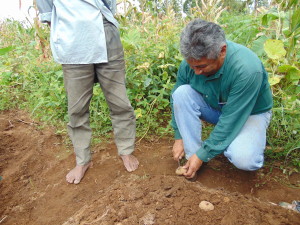 The visiting group also came across farmers planting potato. Dr Francisco offered the farmers with the useful tip of splitting a potato seed into four, with each piece having at least one eye, in the case of low availability of seeds.
The visiting group also came across farmers planting potato. Dr Francisco offered the farmers with the useful tip of splitting a potato seed into four, with each piece having at least one eye, in the case of low availability of seeds.
Realsing also took the group to where he kept bees. The hives were built in a traditional way from logs and covered with heavy rocks to protect them from wild animals. To the astonishment of his companions, Realsing was able to put his hand into the hive and take out pieces of honey laden combs. 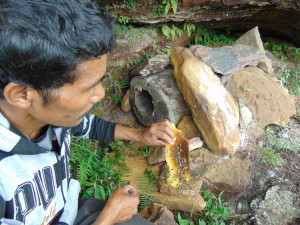 The bees were surprisingly docile and never attacked him once. It is said that bee keepers share a strong relationship with the bees they keep and that they take care of them as though they were their children. In return, the bees recognize their keeper and rarely sting them; they tend to sting their keepers when they handle them while being intoxicated. Pius Ranee, reporting from the field says that the farmers consider stings by their bees “love bites”.
The bees were surprisingly docile and never attacked him once. It is said that bee keepers share a strong relationship with the bees they keep and that they take care of them as though they were their children. In return, the bees recognize their keeper and rarely sting them; they tend to sting their keepers when they handle them while being intoxicated. Pius Ranee, reporting from the field says that the farmers consider stings by their bees “love bites”.
The group also happened upon a stretch of land where broomstick was being cultivated. A barren patch right in the middle of the field stood out where weedicides were used in the past. Realsing expressed his pain at how the soil of his community is being destroyed by broomstick cultivation and his wish to sensitize his community members about the evils of broomstick cultivation and use weedicides.
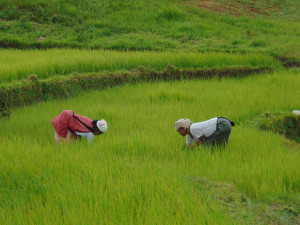 The visitors later came across some women in their paddy fields. Seeing that the crops were quite healthy, they stopped to chat with the women. When asked if they used chemical fertilizers, the women said that they never used fertilizers and that they used only cow dung and cattle bones. In contrast the team also came upon a paddy field that was unhealthy due to fungal infection. Dr Francisco immediately and correctly deduced that the field has been cultivated on for over three years and that the farmer was using urea to fertilize the soil. He told the farmer that it was the over use of urea that was attracting the fungus and causing the yellowing of the leaves. He also suggested that rather than sprinkling the crops with urea they should sprinkle the powder is smaller amounts close to the roots. A more permanent solution was, however, giving up of use of the chemical fertilizers and replacement with natural fertilizers and leaving the plot fallow for a minimum of three years to let it regain its fertility.
The visitors later came across some women in their paddy fields. Seeing that the crops were quite healthy, they stopped to chat with the women. When asked if they used chemical fertilizers, the women said that they never used fertilizers and that they used only cow dung and cattle bones. In contrast the team also came upon a paddy field that was unhealthy due to fungal infection. Dr Francisco immediately and correctly deduced that the field has been cultivated on for over three years and that the farmer was using urea to fertilize the soil. He told the farmer that it was the over use of urea that was attracting the fungus and causing the yellowing of the leaves. He also suggested that rather than sprinkling the crops with urea they should sprinkle the powder is smaller amounts close to the roots. A more permanent solution was, however, giving up of use of the chemical fertilizers and replacement with natural fertilizers and leaving the plot fallow for a minimum of three years to let it regain its fertility.
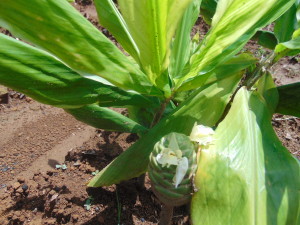 Dr Francisco also showed how he was so eager to learn from the communities he was visiting. He showed great interest in how the ‘Lakdong’ turmeric was grown, traditional practices related to framing the plant and its uses.
Dr Francisco also showed how he was so eager to learn from the communities he was visiting. He showed great interest in how the ‘Lakdong’ turmeric was grown, traditional practices related to framing the plant and its uses.
Reported by Pius Ranee and Kegitar Lyngdoh Lyngkhoi
 Translate
Translate




